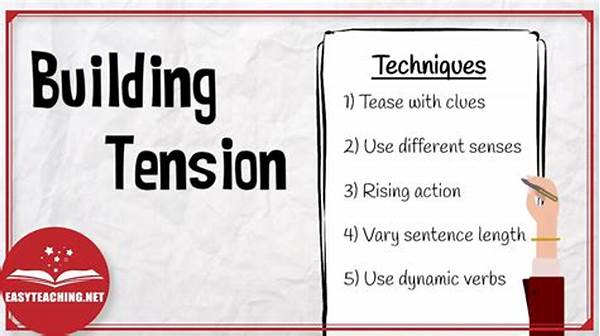Crafting a compelling narrative is an art form that requires skillful storytelling techniques. One of the most significant aspects of storytelling is balancing narrative tension and resolution. This balance not only keeps readers engaged but also ensures that they are satisfied with the story’s conclusion. Achieving this balance involves creating a sense of anticipation and anxiety through tension and subsequently providing relief and satisfaction through resolution. A deep understanding of how these elements work together can transform a good story into an unforgettable one.
Read Now : Developing Multidimensional Story Narratives
The Essence of Tension and Resolution
At the heart of storytelling lies the intricate dance between tension and resolution. Tension is the driving force that propels a story forward, compelling readers to turn the pages. It creates questions, uncertainties, and conflicts that demand answers. Effective tension captivates the audience, keeping them on the edge of their seats, yearning to know what happens next. However, tension without resolution can leave readers frustrated or disappointed. Therefore, balancing narrative tension and resolution is paramount. Resolution delivers answers, closure, and satisfaction, tying up loose ends and providing a sense of fulfillment. When executed effectively, this balance elevates a narrative, making it memorable and impactful. The key is to maintain an ebb and flow, ensuring the story remains dynamic and engaging throughout.
Strategies for Balancing Narrative Tension and Resolution
1. Develop Compelling Characters: Invest in characters with depth to ensure that their arcs naturally create tension and resolution.
2. Use Cliffhangers Sparingly: While cliffhangers heighten tension, overuse can lead to a lack of resolution, frustrating the audience.
3. Pacing Matters: Properly pacing the rise and fall of tension keeps the narrative exciting without overwhelming the reader.
4. Foreshadowing Techniques: Provide subtle hints about potential resolutions that keep readers intrigued and add layers to the plot.
5. Balance Subplots: Integrate subplots that mirror the main narrative to enrich the tension and provide additional resolution.
Adopting a Balanced Approach
The process of balancing narrative tension and resolution requires both creativity and mindfulness. Writers must be aware of the story’s beats, ensuring a harmonious blend of conflict and closure. Tension should be woven into the narrative fabric, creating an emotional undertow that captivates readers. On the flip side, resolutions should not come across as forced or rushed. They must feel organic and true to the story’s development. By consciously managing these elements, the narrative works as a cohesive whole, allowing readers to experience both heart-pounding moments and satisfying conclusions. Crafting such a story is not merely about maintaining equilibrium, but about enhancing the reader’s journey through expertly intertwined tension and resolution.
Techniques to Foster Narrative Balance
1. Craft Clear Goals: Establish explicit objectives for the characters, providing a roadmap that guides tension and promises resolution.
2. Experiment with Structure: Play with non-linear storytelling to manipulate tension and resolution in innovative ways.
3. Dialogue as a Tool: Use dialogue to heighten tension or deliver crucial resolutions effectively within the narrative.
4. Emphasize Emotional Arcs: Highlight characters’ emotional growth to create natural tension and satisfying resolutions.
5. Setting and Atmosphere: Utilize setting to reflect and amplify narrative tension and deliver resolution through transformative environments.
Read Now : Digital Art Tools For Beginners
6. The Role of Conflict: Introduce varying types of conflict—internal and external—to build tension and drive towards resolution.
7. Consistent Theme Exploration: Ensure the main theme is interwoven throughout, aiding in balancing tension and resolution.
8. Creative Use of Time: Manipulate time through flashbacks or flash-forwards to create suspense and satisfying closures.
9. Dynamic Plot Twists: Introduce unexpected turns that revitalize tension and lead to unforeseen resolutions.
10. Revisiting Prior Threads: Periodically revisit earlier plot points to create cyclical tension and resolution within the narrative.
Crafting a Cohesive Narrative Journey
Balancing narrative tension and resolution extends beyond mere plot mechanics. It involves crafting a cohesive journey that evokes emotion and inspires readers. Narratives are not static; they are evolving tapestries of conflict and harmony. For a writer, understanding the pulse of this balance is crucial. Tension acts as a magnet—it draws readers into the world created within the pages. Yet, if the magnetic pull becomes too intense without reprieve, the reader’s connection might fray. Similarly, resolution acts as a gentle landing, ensuring readers walk away with a sense of completion. This dynamic should reflect the ebb and flow of real life, presenting an authentic experience that resonates on a deeper level.
The success of a narrative often hinges on the author’s ability to juggle the quivering strings of tension and the soothing balm of resolution. In practice, this means allowing characters to experience conflict, letting tensions rise, and subsequently guiding them towards meaningful resolutions. This rhythmic progression engages readers, offering both the thrill of uncertainty and the comfort of closure. A well-balanced narrative leaves a lasting impression, one that speaks to the complexities of human emotions and experiences.
Mastering the Art of Narrative Balance
In mastering the art of balancing narrative tension and resolution, one embarks on a journey of exploration and understanding. Writers strive to push the boundaries of their stories, delving into the intricate dance between elements that seem opposed yet complement one another. This mastery is achieved through continuous practice, reflection, and a relentless pursuit of storytelling finesse. The beauty of storytelling lies in its fluidity—the capacity to adapt, evolve, and perpetually refine the delicate equilibrium between tension and resolution. Through this diligence and creativity, a storyteller crafts a narrative that resonates, enlightening readers and leaving them yearning for more.
A Concluding Reflection
In summary, balancing narrative tension and resolution is a fundamental aspect of storytelling that requires both artistry and technique. It demands an acute awareness of story dynamics and a commitment to nurturing a narrative that resonates on multiple levels. As writers delve into the art of creating compelling narratives, they become adept in weaving tension and resolution into a cohesive tapestry. Embracing this balance, they craft stories that not only captivate but also leave an indelible mark on their audiences. Through the power of storytelling, we explore the human condition, bridging gaps between conflict and harmony, and ultimately finding solace in resolution.



